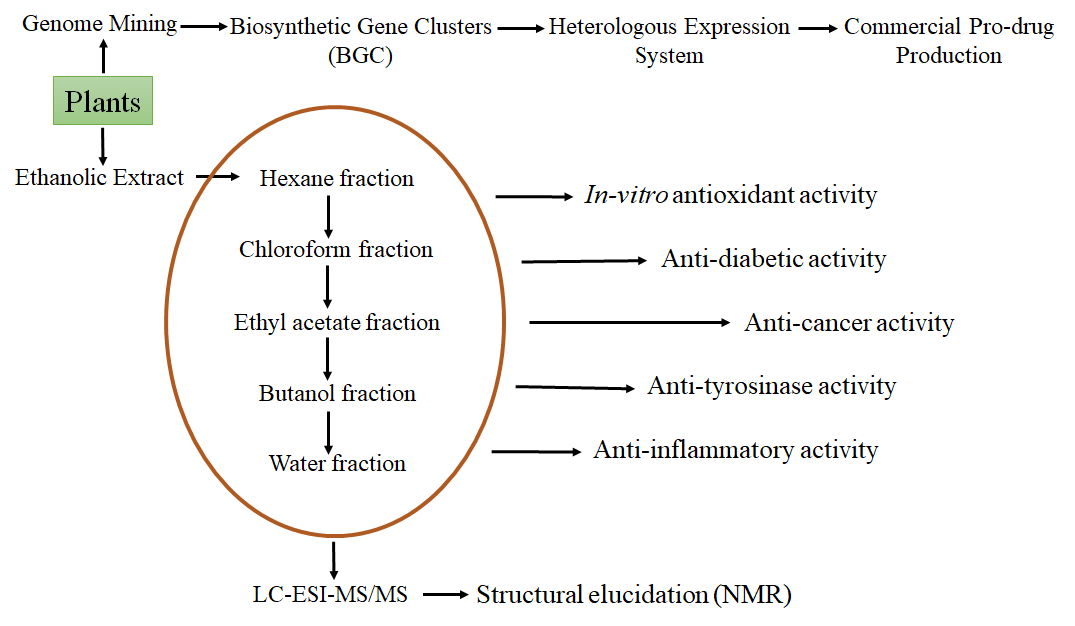Secondary metabolites, used as a single compound or as a mixture, are medicines that can be effective and safe even when synthetic drugs fail. They may even potentiate or synergize the effects of other compounds in the medicine. To meet the positive demands, heterologous expression of the genes involved in the biosynthesis of the potent compound will help in the production on the required scale. Further modifications to enhance the ADME properties of the compounds will have a significant advantage in the drug’s biological activities and bioavailability.
- Secondary metabolites
- Medicinal plants
- Biological activities
- HPLC
- Methylation
Background
There has been extensive research on medicinal plants for their use as alternative medicine and nutraceuticals [1][2]. Most of the plants found in nature produce the secondary metabolites (SM) during their stress conditions, and these are essential for their survival (Plant immunity) [3]. Secondary metabolites are compounds other than primary metabolites and are not required for the plant for metabolic functions. SM are composed of phenolic compounds, aromatic compounds, flavonoids, anthraquinones, terpenoids, alkaloids, antibiotics, quinolines etc. to name a few selected important ones [4]. These SM have found to be beneficial to humans and animals as they have demonstrated an array of pharmacological benefits like anti-oxidant, anti-tumor, anti-bacterial, anti-inflammatory, anti-diabetic, anti-allergic, anti-fungal, etc. [5][6].
In this context, it’s important that we research on medicinal plants having biological activities elucidate their chemical structures along with their commercial-scale production using their biosynthetic gene clusters in a heterologous host. The new discoveries may help us to combat the present hot topic of antibiotic resistance, diabetes, address the cure for cancer and HIV infections, along with many other diseases [7][8].
Research design
Plant materials will be collected and the scientific name of the plants will be identified from the concerned authorities. Crushed and powdered plant samples will be either extracted with ethanol, hexane and ethyl acetate or separately scrubbed hydro distilled in a Clevenger-type apparatus to get the oils. The extracts and the oils from the plants will be analyzed using HPLC, LC-MS, GC, and GC-MS to find the compounds present in the sample. Each fraction of extract will be evaluated for biological activities like anti-oxidant potential, anti-cholinesterase activity, anti-inflammatory activity, anti-diabetic activities, etc. The active major component of the fraction will be further processed for structural elucidation using NMR. If we get a novel compound, we may want to do genome sequencing of the plant and obtain the biosynthetic pathways using bioinformatic tools (Genome mining). The pathway may also be introduced in heterologous hosts like E. coli for mass production of the active compounds. Further modifications like glycosylation, methylation, hydroxylation, sulfonation, etc. could be experimented to enhance the ADME properties and bioactivities of the compounds.

References
- Aryal, S., Baniya, MK., Danakhu, K., Kuwar, P., Gurung, R., Koirala, N., 2019. Total phenolic, flavonoid content and antioxidant potential of wild vegetables from western Nepal. Plants. 8(4), 96.
- Aryal, S., Adhikari, B., Panthi, K., Aryal, P., Mallik, S.K., Bhusal, R.P., Salehi, B., Setzer, W.N., Sharifi-Rad, J., Koirala, N., 2019. Antipyretic, antinociceptive, and anti-inflammatory activities from Pogostemon benghalensis leaf extract in experimental Wister rats.Medicines. 6(4), 96.
- Koirala, N., Pandey, R.P., Thuan, N.H., Ghimire, G.P, Jung, H.J, Oh, T.J, Sohng, J.K., 2019. Metabolic engineering of Escherichia coli for the production of isoflavonoid-4՛-O-methoxides and their biological activities. Biotechnol. Appl. Biochem. 66(4), 484-493.
- Koirala, N., Thuan, N.H., Ghimire, G.P., Thang, D.V., Sohng, J.K., 2016. Methylation of flavonoids: chemical structures, bioactivities, progress and perspectives for biotechnological production. Enzyme Microb. Technol. 86, 103-116.
- Koirala, N., Pandey, R.P., Thang, D.V., Jung, H.J., Sohng, J.K., 2014. Glycosylation and subsequent malonylation of isoflavonoids in E. coli: Strain development, production and insights into future metabolic perspectives. J. Ind. Microbiol. Biotechnol. 41, 1647-1658.
- Koirala, N., Pandey, R.P., Parajuli, P., Jung, H.J., Sohng, J.K., 2014. Methylation and subsequent glycosylation of 7,8-dihydroxyflavone. J. Biotech 184, 128-137.
- Russo, D., Valentão, P., Andrade, P.B., Fernandez, E., Milella, L., Choi, C.W., 2015. Evaluation of antioxidant, antidiabetic and anticholinesterase activities of Smallanthus sonchifolius Landraces and correlation with their phytochemical profiles. Int. J. Mol. Sci. 16(8), 17696-17718.
- Pan, S.Y., Zhou, S.F., Gao, S.H., Yu, Z.L et al., 2013, New perspectives on how to discover drugs from herbal medicines: CAM's outstanding contribution to modern therapeutics. Evid.-Based Complementary Altern. Med 627375.
